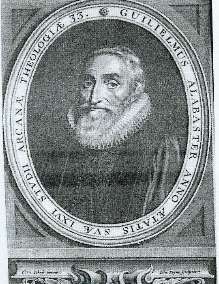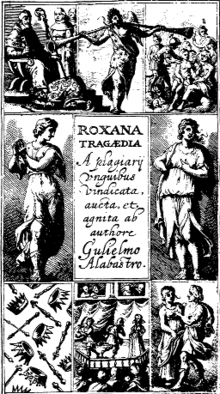William Alabaster
William Alabaster (also Alablaster, Arblastier) (27 February 1567 – buried 28 April 1640)[1] was an English poet, playwright, and religious writer.[lower-alpha 1][2]

Alabaster became a Roman Catholic convert in Spain when on a diplomatic mission as chaplain. His religious beliefs led him to be imprisoned several times; eventually he gave up Catholicism, and was favoured by James I. He received a prebend in St Paul's Cathedral, London, and the living of Therfield, Hertfordshire. He died at Little Shelford, Cambridgeshire.
Biography

Alabaster was born at Hadleigh, Suffolk,[3] the son of Roger Alabaster of the cloth merchant family from Hadleigh in Suffolk, and Bridget Winthrop of Groton, Suffolk.[lower-alpha 2][4] He was educated at Westminster School, and Trinity College, Cambridge from 1583.[3][5] He became a fellow of Trinity, and in 1592 was incorporated of the university of Oxford. About 1592 he produced at Trinity College his Latin tragedy of Roxana.[3]
In June 1596 Alabaster sailed with Robert Devereux, Earl of Essex, on the expedition to Cadiz in the capacity of chaplain, and, while he was in Spain, he became a Roman Catholic. An account of his change of faith is given in an obscurely worded sonnet contained in an manuscript copy of Divine Meditations, by Mr Alabaster.[6] He defended his conversion in a pamphlet, Seven Motives, of which no copy is extant.[lower-alpha 3] It appears that Alabaster was imprisoned for his change of faith in the Tower of London during 1598 and 1599.[3]
In 1607 Alabaster published at Antwerp Apparatus in Revelationem Jesu Christi, in which his study of the Kabbalah gave a mystical interpretation of Scripture. The book was placed on the Index Librorum Prohibitorum at Rome early in 1610. He went to Rome and was there imprisoned by the Inquisition, but succeeded in escaping to England and again embraced the Protestant faith.[7]
After returning to England Alabaster became a doctor of divinity at Cambridge University and chaplain to King James I. After his marriage in 1618 his life now became more settled and he devoted his later years to theological studies.[3][8] He died in 1640[3] at Little Shelford, Cambridgeshire.[9]
Works
Roxana is modelled on the tragedies of Seneca, and is a stiff and spiritless work.[lower-alpha 4] Fuller and Anthony à Wood bestowed exaggerated praise on it, while Samuel Johnson regarded it as the only Latin verse worthy of notice produced in England before Milton's elegies. Roxana is founded on the La Dalida (Venice, 1583) of Luigi Groto, known as Cieco di Hadria, and Hallam asserts that it is a plagiarism.[10]
A surreptitious edition in 1632 was followed by an authorized version a plagiarii unguibus vindicata, aucta et agnita ab Aithore, Gulielmo, Alabastro. One book of an epic poem in Latin hexameters, in honour of Queen Elizabeth, is preserved in manuscript (MS) in the library of Emmanuel College, Cambridge. This poem, Elisaeis, Apotheosis poetica, Spenser highly esteemed. "Who lives that can match that heroick song?" he says in Colin Clout's come home againe, and begs "Cynthia" to withdraw the poet from his obscurity.[3][3]
Alabaster's later cabalistic writings are Commentarius de Bestia Apocalyptica (1621) and Spiraculum tubarum (1633), a mystical interpretation of the Pentateuch. These theological writings won the praise of Robert Herrick, who calls him "the triumph of the day" and the "one only glory of a million".[3]
List of works:[3]
- Roxana – (c. 1595) Latin drama.
- Elisaeis – Latin epic on Elizabeth I.
- Apparatus in Revelationem Jesu Christi (1607).
- De bestia Apocalypsis (1621)
- Ecce sponsus venit (1633)
- Spiraculum Tubarum (1633)
- Lexicon Pentaglotton, Hebraicum, Chaldaicum, Syriacum, Talmudico-Rabbinicon et Arabicum (1637)
Family
In 1618 Alabaster married Katherine Fludd, a widow, and was linked by marriage to the celebrated physician and alchemist Robert Fludd.[3]
Notes
- His surname, sometimes written Arblastier, is one of the many variants of arbalester, a cross-bowman.Chisholm 1911, p. 466
- He was, so Fuller states, a nephew by marriage of Dr John Still, Bishop of Bath and Wells (Chisholm 1911, p. 466). Bridget Winthrop was the sister of Adam Winthrop (1548–1623) whose first wife was Alice Still, sister of Bishop John Still. The marriage was short; she died three years later in childbirth.[4]
- The proof of its publication only remains in two tracts, A Booke of the Seuen Planets, or Seuen wandring motives of William Alablaster's wit, by John Racster (1598), and An Answer to William Alabaster, his Motives, by Roger Fenton (1599).[3]
- For an analysis of the Roxana see an article on the Latin university plays in the Jahrbuch der Deutschen Shakespeare Gesellschaft (Weimar, 1898).[3]
- Bremer, Francis J. "Alabaster, William". Oxford Dictionary of National Biography (online ed.). Oxford University Press. doi:10.1093/ref:odnb/265. (Subscription or UK public library membership required.)
- "New General Catalog of Old Books & Authors".
- Chisholm 1911, p. 466.
- Fuller, vol ii, p. 343; Camp, p.
- ACAD & ALBR584W.
- see J. P. Collier, Hist. of Eng. Dram. Poetry, ii. 341.Chisholm 1911, p. 466
- Chisholm 1911, p. 466 citing the preface to Alabaster's Ecce sponsus venit (1633), a treatise on the time of the second advent of Christ
- Drabble 2000, p. 13.
- Editors of Encyclopædia Britannica. "William Alabaster | English scholar". www.britannica.com. Retrieved 4 July 2016.CS1 maint: extra text: authors list (link)
- Chisholm 1911, p. 466 cites Hallam Literature of Europe, iii.54.
References
- "Alabaster, William (ALBR584W)". A Cambridge Alumni Database. University of Cambridge.
- Camp, Charles L. N. Winthrop family tree. New Haven, Conn. – Traces the lineage of the Winthrop family from 1498 forward 200 years.
- Drabble, Margaret, ed. (2000). The Oxford Companion to English Literature (6th ed.). Oxford University Press, 2000.CS1 maint: ref=harv (link)
- Fuller, Thomas. Worthies of England. ii. p. 343.
Attribution

- T. Fuller, Worthies of England (ii. 343)
- J. P. Collier, Bibl. and Crit. Account of the Rarest Books in the English Language (vol. i. 1865)
- Pierre Bayle, Dictionary, Historical and Critical (ed. London, 1734)
- The Athenaeum (December 26, 1903), where Mr. Bertram Dobell describes a MS. in his possession containing forty-three sonnets by Alabaster.
Further reading
- Story, G. M.; Gardener, Helen, eds. (1959). The Sonnets of William Alabaster.
- Sullivan, Ceri Sullivan. Dismembered Rhetoric: English Recusant Writing, 1580–1603.
- Sullivan, Ceri Sullivan (2000). "The physiology of penance in weeping texts of 1590s". Cahiers Élisabéthains. 57: 31 48. both books Ceri Sullivan, examine Alabaster's prose and poetry respectively.
External links
| Wikisource has the text of the 1885–1900 Dictionary of National Biography's article about William Alabaster. |